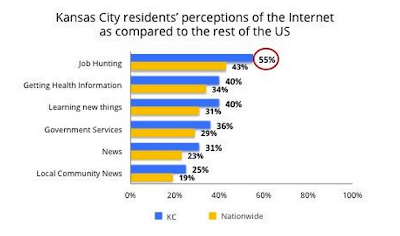Our goal is to build products that will help improve our users’ lives. And when it comes to Internet access, it's clear what provides a better user experience:
Fast is better than slow. On the web, nobody wants to wait for a video to buffer or a website to load.
Abundance is better than scarcity. There’s a plethora of rich content available online—and it’s increasingly only available to people who have the speeds and means to access it.
Choice is better than no choice. Competition and choice help make products better for users.
With that in mind, we embarked on a journey to bring ultra-high speeds to Kansas City, Kan. and Kansas City, Mo. And today, we’re excited to announce Google Fiber. Google Fiber is 100 times faster than today’s average broadband. No more buffering. No more loading. No more waiting. Gigabit speeds will get rid of these pesky, archaic problems and open up new opportunities for the web. Imagine: instantaneous sharing; truly global education; medical appointments with 3D imaging; even new industries that we haven’t even dreamed of, powered by a gig.
When we asked people what they value in their Internet service, the majority of them simply said, “choice.” So we listened. Kansas Citians will choose where we install and when. We’ve divided Kansas City into small communities we call “fiberhoods.” To get service, each fiberhood needs a critical mass of their residents to pre-register. The fiberhoods with the highest pre-registration percentage will get Google Fiber first. Households in Kansas City can pre-register for the next six weeks, and they can rally their neighbors to pre-register, too. Once the pre-registration period is over, residents of the qualified fiberhoods will be able to choose between three different packages (including TV).
It’s easy to forget how revolutionary high-speed Internet access was in the 1990s. Not only did broadband kill the screeching sound of dial-up, it also spurred innovation, helping to create amazing new services as well as new job opportunities for many thousands of Americans. But today the Internet is not as fast as it should be. While high speed technology exists, the average Internet speed in the U.S. is still only 5.8 megabits per second (Mbps)—slightly faster than the maximum speed available 16 years ago when residential broadband was first introduced. Access speeds have simply not kept pace with the phenomenal increases in computing power and storage capacity that’s spurred innovation over the last decade, and that’s a challenge we’re excited to work on.
To find out more about the different service packages and the pre-registration process see our Google Fiber Blog, which we’ll regularly update with new information over the coming weeks. This is an exciting new project for Google and we can’t wait to get homes connected to Google Fiber in Kansas City—because we’re pretty certain that what people do with a gig will be awesome.



